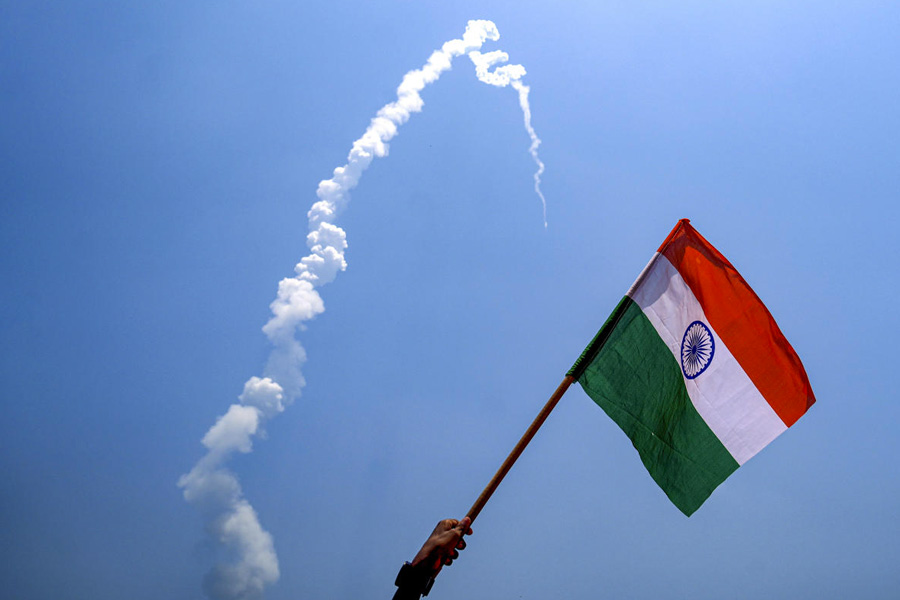In yet another success for its space programme, India's first solar mission craft Aditya L1 on Saturday reached its destination, the L1 point, about 1.5 million kilometres from Earth from where it will orbit the Sun and study our star's wonders, uninterrupted by eclipses and occultations.
Prime Minister Narendra Modi made the announcement on ISRO's latest feat, which comes months after the success of Chandrayaan-3 where the space agency achieved the challenging soft landing of the craft on the lunar surface.
The Lagrange point 1 (L1) of the Sun-Earth system is about one per cent of the total distance between the Earth and the Sun.
A satellite in a halo orbit around the L1 point has the major advantage of continuously viewing the Sun without any occultations/eclipses, ISRO officials said, adding, this will provide a greater advantage in observing solar activities and their effect on space weather in real time.
"India creates yet another landmark. India’s first solar observatory Aditya-L1 reaches its destination. It is a testament to the relentless dedication of our scientists in realising among the most complex and intricate space missions."
"I join the nation in applauding this extraordinary feat. We will continue to pursue new frontiers of science for the benefit of humanity," he said in a post on micro-blogging site 'X.'
Union Minister Jitendra Singh, who among others holds the Space portfolio, said: "From Moon walk to Sun Dance! What a glorious turn of year for Bharat!"
"Under the visionary leadership of PM @narendramodi, yet another success story scripted by Team #ISRO. #AdityaL1 reaches its final orbit to discover the mysteries of Sun-Earth connection," he wrote on 'X.'
A Polar Satellite Launch Vehicle (PSLV-C57) launched the Aditya-L1 spacecraft from the second launch pad of Satish Dhawan Space Centre (SDSC), Sriharikota, on September 2 last year.
After a flight duration of 63 minutes and 20 seconds, it was successfully injected into an elliptical orbit of 235x19500 km around the Earth then.
It underwent a series of maneuvers thereafter and headed L1, having escaped the Earth's sphere of influence.
The spacecraft carries seven payloads to observe the photosphere, chromosphere and the outermost layers of the Sun (the corona) using electromagnetic and particle and magnetic field detectors.
"Using the special vantage point L1, four payloads directly view the Sun and the remaining three carry out in-situ studies of particles and fields at the Lagrange point L1, thus providing important scientific studies of the propagatory effect of solar dynamics in the interplanetary medium," according to the space agency.
The suits of Aditya L1 payloads are expected to provide the "most crucial information" to understand the problem of coronal heating, coronal mass ejection, pre-flare and flare activities and their characteristics, dynamics of space weather, and propagation of particles and fields, officials said.
The major science objectives of the Aditya-L1 mission are:
- Study of the Solar upper atmospheric (chromosphere and corona) dynamics.
- Study of chromospheric and coronal heating, physics of the partially ionized plasma, initiation of the coronal mass ejections, and flares.
- Observe the in-situ particle and plasma environment, providing data for the study of particle dynamics from the Sun.
- Physics of the solar corona and its heating mechanism.
- Diagnostics of the coronal and coronal loops plasma: Temperature,velocity and density.
- Development, dynamics and origin of coronal mass ejections (CMEs).
- Identify the sequence of processes that occur at multiple layers (chromosphere, base and extended corona) which eventually leads to solar eruptive events.
- Magnetic field topology and magnetic field measurements in the solar corona.
- Drivers for space weather (origin, composition and dynamics of solar wind).










